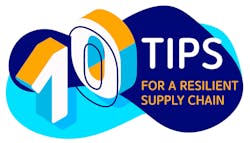10 ways to build post-pandemic Supply Chain resilience
Ultimately, if we have learned anything through the global COVID-19 pandemic, it is that when push comes to shove and access and availability are at a premium, we come to the realization that we do not need the “best” gloves or swabs. We need consistency and reliability. So how do we achieve that? Let me share 10 ideas for you to consider.
1. Map your Supply Chain. Identify areas of risk, such as where your supplier is located, where the raw materials come from, and what their market share is. In my role, our category managers are required to know their products inside and out. This is precisely why we can help our clients procure hard to find products with a bit of focus and outside-the-box thinking.
2. Remain agile. Design and implement a sourcing process that pre-identifies stakeholders so you can make necessary decisions on options ahead of time. Remember, sometimes you find solutions in the simplest form. For example, you already know 90% of the products that will be hard to source in another pandemic, such as disinfectant wipes, hand sanitizer and toilet paper.
3. Hold suppliers accountable. The best way to hold suppliers accountable is to have a backup plan and be willing to execute on that plan. Health systems have encountered shortages before, and I know from personal experience that nearly every health system will go back to the original supplier that failed them. Why? Because of convenience and ease. The potential to lose business is the best way to hold suppliers accountable. Remember, if you’re agile, you can move the business. It’s likely you have done this already during this pandemic.
4. Secure local contracts. They can make a tremendous difference when you need them the most. You must control your supply chain and own it! There is no one else that has more “skin in the game” than you do for the organization you work for, the organization that pays you, and the organization that serves your community.
5. Ask for help. If you do not have the experience or resources, there is nothing wrong with asking for help. It is certainly uncomfortable but asking for help and succeeding is a much-preferred alternative and makes for an easier discussion with your boss than trying to do it yourself and failing! There are plenty of companies in business whose primary purpose is to support, assist, train and implement.
6. Source domestically (when possible). It is not only good for our communities and sustainability, but it also presents less risk. You may pay a premium but think of the premium you are paying today when you cannot find critical products from others. However, do not assume they are 100% risk-free; they only may offer less risk. Just because the supplier may be down the street, you still need to hold them accountable.
7. Set targets for your team. Because it is a team effort, make everyone part of it and make it fun. Make sure your team has time to do their day jobs, but at the same time make sure the team allocates 5% to 10% of their time to special projects. You will be surprised at how empowering this can be and how these special projects infuse energy into the organization.
8. Empower your Supply Chain team. Listen generously to your team and make them a part of the sourcing process. Keep in mind that negotiations start at the first conversation. Do not source in a vacuum.
9. Engage clinical stakeholders early. If an initiative is kicked off by Supply Chain, we should be engaging our clinical stakeholders and end users early. There is an internal fear of upsetting clinicians in most healthcare settings, therefore some hesitancy to engage them. Waiting too long to engage the right people can torpedo an initiative at the last minute. There will be some uncomfortable discussions, some tension and candid discussions between “clinical” and “admin” staff, but this is healthy. Utilizing their experience and sitting down to understand preferences helps to establish a mutual respect. It’s not easy, but the earlier you can engage clinical stakeholders, the better it tends to go.
10. Do not let perfect get in the way of good. When it comes to sourcing products, I have seen too many times in healthcare sourcing that perfection can cripple an organization from making a decision. Think systematically, find a solution, implement the solution and continuously improve the solution.
Would you believe me if I told you there were many health systems out there that have very limited supply shortages? It is true! They took matters into their own hands early, remained agile, partnered to source locally, asked for help and did not let perfect stand in the way of good.
That said, we all work hard and still have the best healthcare systems in the world, but we need to continuously raise the standard and improve together.
